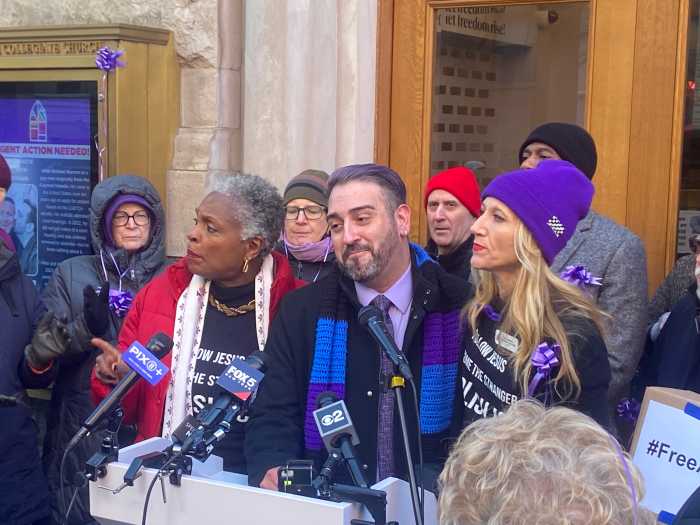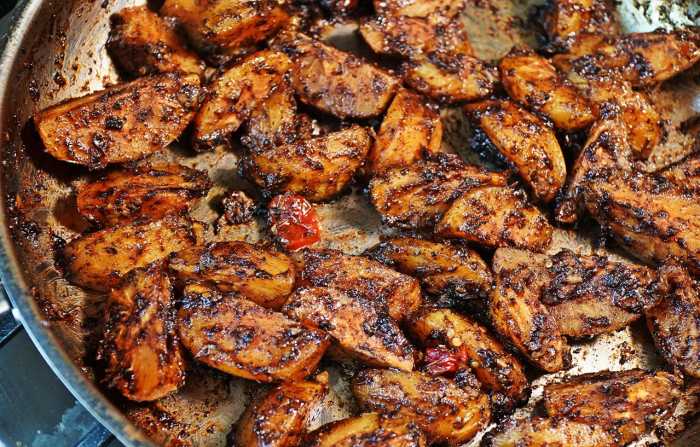It’s late summer and by now all the food
that I longed for during the cold winter months has begun to
bore me.
I didn’t think I’d ever have enough of big green salads brimming
with fresh-from-the-farmers market lettuce and perfect cucumbers;
or delicate, cold pea soups tinged with mint or burgers hot off
the grill. Yet, after so many impromptu picnics and quick, thrown
together dinners, as delicious as they are, I’m sated. I still
want to eat cool, light, easy to prepare dishes, but I crave
complexity. More layers of flavors. Something spicy.
What I want now is ceviche.
Ceviche (also spelled seviche and pronounced seh-VEE- cheh) is
a Latin American dish made by marinating fish or shellfish in
citrus juice and serving it cold or cool. Other ingredients vary
according to region, but a mixture of fresh herbs, tomatoes or
tomato juice, and sometimes chopped peppers and onions are added.
With its fresh, vibrant flavors, ceviche works like a cold shower
on a tired palate.
Most often prepared with mildly flavored fish such as red snapper,
sea bass, sole or tilapia, the fish is sliced thin or cut into
small chunks and is "cooked" by the acids in lemon
or lime juices or a mixture of both until it’s firm and opaque.
(The Ecuadorian version often replaces the lemon and lime with
the juice of an orange.) The fish cooks in a matter of minutes
or several hours depending on the amount and the thickness of
the pieces. If whole shrimp, large pieces of lobster, calamari,
scallops or clams are used, they must be briefly boiled or gently
poached, then marinated for a short time to insure that the pieces
are fully cooked.
The dish is eaten as an appetizer, sometimes with crackers, or
as an entree with white rice.
Some historians believe the dish originated in Peru or Ecuador,
while others believe that ceviche is Arabian, imported to Peru
by Arabian immigrants and then re-interpreted by Peruvians living
along the coastal areas.
There are several theories regarding the origin of the word ceviche.
One theory is that it derives from the Peruvian mispronunciation
of English-speaking visitors saying, "See the beach."
Another is that the word spelled cebiche, comes from the Spanish
verb cebar, "to saturate."
Two Brooklyn restaurants that serve ceviche are El Conquistador
#1 in Park Slope, where chef Jose Palaguchi serves a number of
Ecuadorian-style ceviches, and the Latin Grill in Cobble Hill,
where chef Arturo Tellez serves a delightful Mexican rendition.
My husband and I braved the brutal heat to sample El Conquistador’s
reputably delicious shellfish ceviche. While we waited for our
order, we downed ice-cold Coronas and watched Spanish soap operas
in the multi-mirrored, wood-paneled dining room.
Year-old El Conquistador #1 serves a half-Ecuadorian and half-Italian
menu. The Ecuadorian side is heavy on fish dishes, sopas (soups)
and multi-ingredient carnes (meat dishes). The Italian half features
inventive pasta dishes, simple grilled or sauteed pesce (fish)
and traditional chicken, veal and beef entrees.
Shrimp or a combination of shrimp and other shellfish are the
ingredients most often found in Ecuadorian ceviche. Ecuador-born
Palaguchi serves three different shrimp-based ceviches. On the
weekend, he offers cocktail de camarones or shrimp cocktail.
Of the ceviches we tried, this "cocktail," amusingly
presented in a cocktail glass complete with big, lemon-flavored
shrimp hugging the rim, had the most unctuous consistency and
the richest flavor. Whole tender shrimp were mixed in a sauce
made thick with avocado chunks, the flavors brightened with the
addition of lemon and a lot of lime juice. Small pungent pieces
of red onion gave the dish a little spice and parsley imparted
a fresh, herbal note.
Served in a porcelain bowl topped with a kitschy-looking lobster,
ceviche mixto, a combination of shrimp and clams, was redolent
of good olive oil and briny, deep shellfish flavor. Crunchy corn
kernels and diced red onion gave the dish textural interest,
and a splash of Tabasco sauce intensified the shellfish flavor.
A platter of white rice, perfectly steamed and placed on a matching
lobster plate, turned the dish into a meal. Palaguchi finishes
the ceviche mixto with a traditional Ecuadorian topping of maiz
tostada or corn nuts – large, deep-fried kernels of corn that
taste like popcorn and have a crunchy texture.
The lightest and simplest of the ceviches, the ceviche de camarones,
served in a small glass bowl, had the most vivid flavors. Palaguchi
tossed tender shrimp in a lemon, tomato juice and olive oil marinade,
sprinkled it with cilantro and topped it with corn nuts.
Mexican chef Arturo Tellez of the Latin Grill also favors shrimp
for his ceviche. Opened last December, the restaurant – all glittery
blue and white tiles and aqua covered diner chairs – specializes
in Mexican and Cuban cuisine. Tellez’s ceviche mariscos (shellfish
ceviche) that he jokingly refers to as an "Acapulco Cocktail,"
is served as an appetizer, but could easily make a light lunch
or supper. Following the ceviche with the chef’s fried plantains
dessert – his are very sweet and crusty and come topped with
a rich vanilla ice cream – makes a memorable meal.
The "Acapulco Cocktail" a mix of shrimp and tender
rings of calamari, had less citrus and pulpier tomato than the
Ecuadorian version. It, too, was served in a large glass, a milkshake
glass in this case, ringed with shrimp and lime wedges.
Tellez’s shrimp and calamari were lightly lemon-flavored, and
the sauce had the sting of hot chili peppers. Each bite of the
ceviche, with its bright herbal notes, lushness of the avocado
and heat of the peppers played a wonderful havoc in my mouth.
Instead of rice, this ceviche comes with Saltines. It works.
El Conquistador #1 (412 Fifth Ave. between
Seventh and Eighth streets) accepts Visa, MasterCard and American
Express. Entree portions of ceviche: $9. Entrees: $6-$13.75.
For information, call (718) 832-0895.
Latin Grill (254 Court St. between Kane and DeGraw streets) accepts
cash only. Ceviche appetizer: $7.50. Entrees: $8.50-$14.50. For
information, call (718) 858-0309.
Ceviche at home
The ceviche mariscos recipe
is adapted from chef Arturo Tellez of the Latin Grill. The success
of the dish depends on the freshness of the fish. Go to a quality
fish market (I’ve recommended three below), and take a sniff
before you buy. Fish or shellfish should have almost no odor.
If it smells fishy, it isn’t fresh.
Latin Grill Ceviche
Mariscos
Adapted from Chef Arturo Tellez’s
recipe
4 ripe tomatoes, diced
1 red onion, diced
2 jalapeno peppers, seeded and diced
1/4 cup lime juice
2 tbsp. ketchup
1 ounce Sangria soda (found in Spanish markets) or mix 1/2 ounce
of fruity red wine with 1/2 ounce of plain seltzer
1 ripe avocado, peeled and cut into chunks
1 cup medium-large shrimp, peeled and de-veined
1 cup calamari, cleaned
1 Bay leaf
Salt and pepper
Lightly poach shrimp and calamari in water seasoned with a
little salt and bay leaf. Slice calamari into rings. Mix diced
ingredients omitting the avocado to create a salsa and mix with
liquid ingredients. Add the shrimp and calamari. Cover, refrigerate
and let ingredients sit for one to two hours. Season to taste
with salt and pepper. Shortly before serving mix in avocado.
Serve with crackers.
Where to shop
Costco Wholesale [976 Third Ave. between 37th and 39th streets,
(800) 774-2678 or (718) 965-7603] This wholesale warehouse has
a well-stocked fish department featuring very fresh fish at prices
lower than most fish markets. It pays to purchase a membership
here or find a Costco member and tag along.
Fish Tales [191A Court St. between Bergen and Wyckoff Streets,
(718) 246-1346] The Zagat survey recently voted this attractive
store No. 1 for service and placed it among the top 40 shops
in Brooklyn for quality. The fish here is the freshest you’ll
find anywhere.
Park Slope Seafood [215 Seventh Ave. between Third and Fourth
streets, (718) 832-7638] This shop stocks a large selection of
fresh fish at reasonable prices.

























